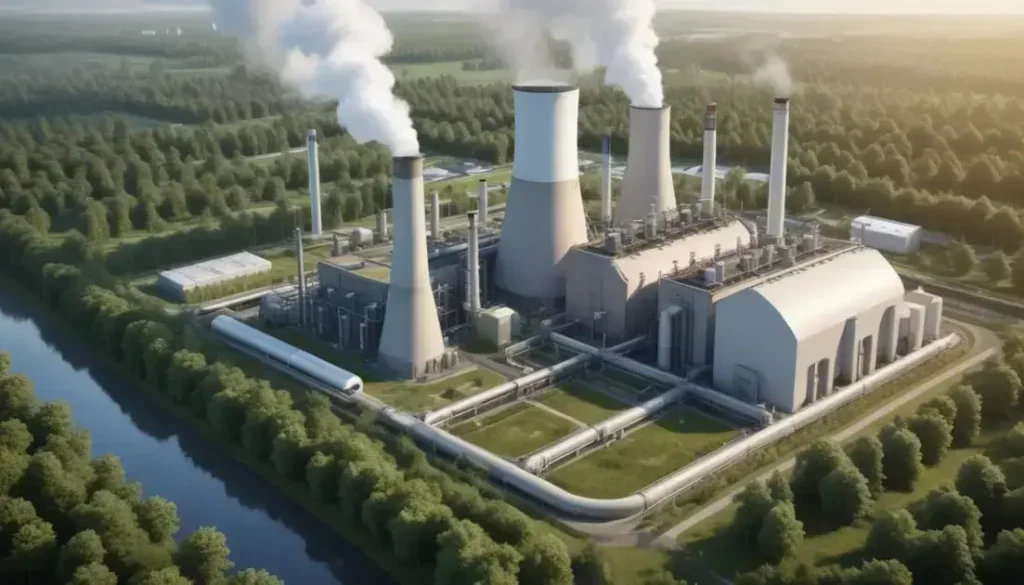Clean energy transition in India involves adopting renewable technologies, leveraging government initiatives, and fostering community engagement to reduce carbon emissions and achieve sustainability goals.
The world of clean energy is evolving rapidly, particularly with ambitious initiatives like Balfour Beatty’s new project. Ready to learn how this could impact you?
Introduction to Balfour Beatty’s involvement
Balfour Beatty has emerged as a key player in the development of clean energy projects, particularly through its investments in modern power generation technologies. The company’s recent involvement in the Teesside Power project showcases its commitment to creating sustainable energy solutions. This initiative focuses on carbon capture technology, which aims to significantly reduce greenhouse gas emissions.
By integrating innovative approaches, Balfour Beatty enhances the efficiency of power generation while addressing environmental concerns. Their collaboration with well-known firms like GE Vernova and Technip Energies reflects a strong partnership that leverages expertise in engineering and technology. Such collaborations are essential for transitioning to a greener energy landscape.
Moreover, the investment made by Balfour Beatty is not just about energy; it’s also about job creation and boosting the local economy in Teesside. With the potential to support numerous jobs during construction and ongoing operations, the project presents a significant opportunity for the workforce. As the demand for renewable energy continues to grow, Balfour Beatty’s strategic positioning in this market will be crucial for future developments.
Overview of Teesside Power project
The Teesside Power project stands as a pivotal initiative in the UK’s clean energy landscape. Envisioned to enhance the efficiency of power generation, this project leverages advanced gas-fired technology, positioning itself at the forefront of reducing carbon emissions. The site’s modern infrastructure will not only contribute to a lower carbon footprint but also support the goal of transitioning to a low-carbon economy.
With an anticipated capacity to generate around 1.5 gigawatts, Teesside Power will be one of the largest gas power stations in the UK. This significant output is essential for catering to the growing energy demands while ensuring sustainability. The integration of carbon capture technology is a game changer, enabling the plant to capture and store a substantial amount of CO2 that would otherwise enter the atmosphere.
Furthermore, the project is set to create numerous jobs during its construction phase and thereafter, providing a boost to the local Teesside economy. By fostering partnerships with local businesses, Teesside Power aims to stimulate economic growth and support regional development. As the project unfolds, its impact on the energy sector will be closely monitored, showcasing a responsible and sustainable approach to energy production.
Importance of carbon capture technology
Carbon capture technology plays a crucial role in the global effort to combat climate change. By capturing up to 90% of carbon dioxide emissions produced from the use of fossil fuels in electricity generation and industrial processes, this technology significantly reduces the amount of CO2 released into the atmosphere.
The adoption of carbon capture is essential for achieving sustainability goals. It allows existing power plants to remain operational while transitioning to lower emissions, providing a necessary bridge in the shift towards renewable energy. This technology is not only beneficial for the environment but also offers economic advantages by enabling power plants to comply with increasingly stringent regulations.
Moreover, carbon capture technology can contribute to the circular economy by repurposing captured CO2 for various industrial applications, such as producing synthetic fuels or boosting agricultural productivity through enhanced carbon utilization. This innovative use of captured carbon presents new business opportunities and can stimulate economic growth.
As countries strive to reduce their carbon footprints, investment in and development of carbon capture technologies will be vital. By embracing this technology, industries can take meaningful steps toward reducing their environmental impact while maintaining energy security and economic stability.
Economic implications for Teesside
The Teesside Power project is set to have significant economic implications for the local region. With an investment in advanced power generation, the project is anticipated to create numerous job opportunities during both its construction and operational phases. This influx of employment will stimulate the local economy, benefiting residents and businesses alike.
By fostering partnerships with local suppliers and contractors, Teesside Power is establishing a model for regional growth. The project aims to prioritize local content, ensuring that many of the materials and services needed are sourced from the surrounding area. This approach not only supports local businesses but also enhances community investment.
Furthermore, the integration of cutting-edge technologies, such as carbon capture, positions Teesside as a leader in sustainable energy. The ability to reduce emissions while generating power means that the region can attract further investments from businesses focused on sustainability. This could lead to an expansion of the clean energy sector in Teesside, creating a more diversified economic base.
Ultimately, the Teesside Power project exemplifies how clean energy initiatives can drive economic growth, create jobs, and enhance regional competitiveness. As the project develops, its impact on employment, local businesses, and the environment will be crucial to the area’s future prosperity.
Impact on job creation in the UK
The Teesside Power project is expected to significantly impact job creation in the UK. With the ongoing push for cleaner energy solutions, this project will generate thousands of jobs during both its construction and operational phases. Local employment opportunities will be a key focus, ensuring that many positions are filled by residents from the Teesside area.
During the construction phase, various roles will be available ranging from skilled tradespeople to project management positions. This influx of jobs will not only support the local economy but also provide vital training opportunities for individuals seeking to enter the renewable energy sector. Additionally, partnering with local educational institutions can help bridge the skills gap.
Once operational, the Teesside Power facility will require a workforce to manage day-to-day operations, maintenance, and monitoring of the carbon capture technology. These long-term positions will contribute to sustainable employment and promote job stability within the community.
The ripple effects of job creation extend beyond immediate employment. As more people enter the workforce, local businesses will benefit from increased spending power. This economic uplift can create a thriving ecosystem, fostering innovation and investment in the region, further enhancing opportunities for growth in the renewable energy sector.
Role of GE Vernova and Technip Energies
GE Vernova and Technip Energies are pivotal players in the Teesside Power project, bringing their expertise in energy solutions and sustainable technologies. As leaders in their respective fields, these companies contribute significantly to the project’s vision of enabling clean energy generation and reducing carbon emissions.
GE Vernova is renowned for its innovative approach to power generation and energy efficiency. By incorporating cutting-edge technologies and expertise in gas turbines, GE Vernova enhances the overall efficiency of the Teesside Power facility. Their role in integrating advanced turbine systems helps in optimizing energy output while minimizing environmental impact.
On the other hand, Technip Energies excels in engineering and technology solutions for energy and chemicals. Their involvement in implementing carbon capture technologies at the Teesside site allows for significant CO2 reduction. This strategic collaboration is crucial for achieving the emissions targets set by the UK government.
Together, GE Vernova and Technip Energies exemplify the power of partnership in addressing global energy challenges. Their combined efforts not only bolster the effectiveness of the Teesside Power project but also set a benchmark for future clean energy initiatives. As the energy landscape evolves, this collaboration represents a crucial step towards a more sustainable and resilient energy future.
Government initiatives supporting clean energy
The UK government has implemented several initiatives to support the transition to clean energy. These strategies aim to reduce carbon emissions while promoting sustainable economic growth. One significant initiative is the Clean Growth Strategy, which outlines the government’s vision for decarbonising the economy and boosting clean growth across various sectors.
Investment in renewable energy technologies has also been prioritized, with substantial funding allocated to offshore wind, solar energy, and nuclear power. The government is actively encouraging public and private partnerships to foster innovation in clean energy technologies. This approach not only supports job creation but also positions the UK as a leader in the global clean energy market.
In addition to financial support, the government has introduced policies that offer incentives for businesses investing in low-carbon technologies. These include tax breaks, grants, and subsidies aimed at facilitating the adoption of sustainable practices. By incentivizing companies to reduce their carbon footprint, the UK aims to achieve its ambitious emissions reduction targets.
Moreover, the government has been vocal in promoting community engagement and awareness regarding clean energy. Initiatives such as educational programs and public consultations play a vital role in ensuring that citizens understand the benefits of transitioning to renewable energy sources. With these comprehensive strategies, the UK government is laying a solid foundation for a sustainable energy future.
Future of low-carbon electricity in the UK
The future of low-carbon electricity in the UK appears promising as the nation steadily transitions towards more sustainable energy sources. With ambitious government targets set for reducing carbon emissions, the commitment to renewable technologies such as wind, solar, and hydropower is stronger than ever. The UK aims to become a net-zero emitter by 2050, compelling a significant shift in how electricity is generated and consumed.
One of the key players in this transition is the increasing investment in offshore wind energy. The UK has the largest offshore wind capacity in the world, and future projects aim to double this capability. This renewable source not only provides a clean alternative to fossil fuels but also creates thousands of jobs, bolstering the economy.
Additionally, energy storage solutions are gaining traction, enabling a reliable supply of electricity even when renewable generation is low. Technologies such as batteries and pumped hydro will play a crucial role in balancing the grid and ensuring energy security.
As electric vehicles (EVs) become more mainstream, the demand for low-carbon electricity will rise, pushing the UK to enhance its grid infrastructure and integrate new energy technologies. With a clear focus on innovation and sustainability, the future of low-carbon electricity in the UK promises a cleaner, more resilient energy landscape.
Challenges and opportunities for Indian firms
Indian firms face a unique set of challenges and opportunities in the evolving landscape of clean energy. With the global push for sustainability, Indian companies must adapt quickly to remain competitive. One primary challenge is the need for significant investment in technology. Many firms lack access to advanced renewable technologies that can enhance efficiency and reduce emissions.
Moreover, regulatory frameworks can be complex and may pose hurdles for firms looking to expand into new clean energy markets. Navigating these regulations requires a deep understanding of both local and global standards, making it essential for companies to engage with policy experts and industry associations.
Despite these challenges, there are substantial opportunities for Indian businesses. The government’s initiatives to promote renewable energy through incentives and subsidies present a fertile ground for investment. Companies can leverage these initiatives to innovate and introduce new products that align with sustainability goals.
Furthermore, as the demand for low-carbon solutions grows, Indian firms have the chance to position themselves as leaders in the green technology space. By collaborating with global partners and investing in research and development, they can develop cutting-edge solutions that not only meet domestic needs but also cater to international markets.
Perspectives on global clean energy transition
The global clean energy transition is gaining momentum as countries worldwide embrace sustainable practices. This shift plays a critical role in combating climate change and fostering economic growth. Many nations are committing to net-zero targets, influencing policies that promote renewable energy sources and energy efficiency.
One promising perspective is the acceleration of renewable energy technologies. Innovations in solar, wind, and energy storage are essential in meeting the increasing demand for clean energy. The rapid decrease in costs associated with these technologies has made them more accessible, enabling countries to diversify their energy portfolios.
Investment in clean energy is also shifting towards emerging markets, where the potential for growth is significant. Countries in Asia, Africa, and Latin America are witnessing substantial investments in renewable infrastructure. This focus helps to create jobs, improve energy access, and stimulate economic development.
Furthermore, international collaborations are becoming vital in the clean energy transition. Sharing knowledge, technology, and resources between countries speeds up the process and enables a coordinated approach to addressing climate challenges. Global partnerships are essential for fostering innovation and driving the development of sustainable energy solutions.
Conclusion and key takeaways
The transition to clean energy is becoming increasingly critical as the world confronts the challenges of climate change. Key takeaways from this discussion highlight the importance of renewable energy technologies and their role in achieving sustainability goals. Investments in solar, wind, and hydropower are essential for a greener future.
Government initiatives provide necessary support for the adoption of clean energy solutions. Policies and incentives significantly influence the pace of this transition, making it vital for industries to align with these frameworks. Collaboration with global partners can drive innovation and enhance the sharing of best practices.
For Indian firms, there are both challenges and opportunities. While navigating regulatory landscapes may pose difficulties, the potential for growth in clean energy positions these companies advantageously in the market. Embracing emerging technologies and sustainable practices will be crucial in forging a path forward.
As we look ahead, public awareness and engagement remain vital in effecting change. Educating communities about the benefits of clean energy fosters support for necessary policies and initiatives. Ultimately, the collective effort will pave the way for a sustainable energy future that benefits everyone.
In Conclusion: Embracing the Clean Energy Future
The transition to clean energy is more than just a trend; it represents a critical pathway for a sustainable future. Embracing renewable energy technologies is essential for reducing our carbon footprint and combating climate change.
Support from governments through policies and initiatives plays a fundamental role in facilitating this shift. For Indian firms, engaging with these opportunities and overcoming challenges will determine their success in the evolving energy landscape.
Community involvement and public awareness are also vital in promoting clean energy solutions. By fostering understanding and support, we can encourage necessary changes and drive innovation.
Ultimately, the journey towards a cleaner energy future requires collective action, collaboration, and commitment from everyone. Together, we can create a thriving and sustainable energy ecosystem that benefits current and future generations.
Frequently Asked Questions
What are the primary benefits of transitioning to clean energy?
Transitioning to clean energy reduces carbon emissions, mitigates climate change impacts, and creates sustainable job opportunities in the renewable energy sector.
How can Indian firms leverage government initiatives for clean energy?
Indian firms can take advantage of government subsidies and incentives designed to promote renewable energy investments and innovation, allowing them to compete effectively.
What role does community engagement play in the clean energy transition?
Community engagement fosters awareness and support for clean energy initiatives, encouraging local participation and helping educate people on sustainability benefits.
What challenges do businesses face when adopting renewable energy?
Businesses may encounter challenges such as high initial investment costs, navigating complex regulations, and the need for access to advanced technologies.
How does international collaboration impact the clean energy transition?
International collaboration leads to knowledge sharing, technology transfer, and innovative solutions, expediting the global transition to sustainable energy practices.
What is the future outlook for low-carbon electricity in the UK?
The future of low-carbon electricity in the UK is optimistic, with continued investments in renewable technologies aimed at achieving net-zero emissions by 2050.


